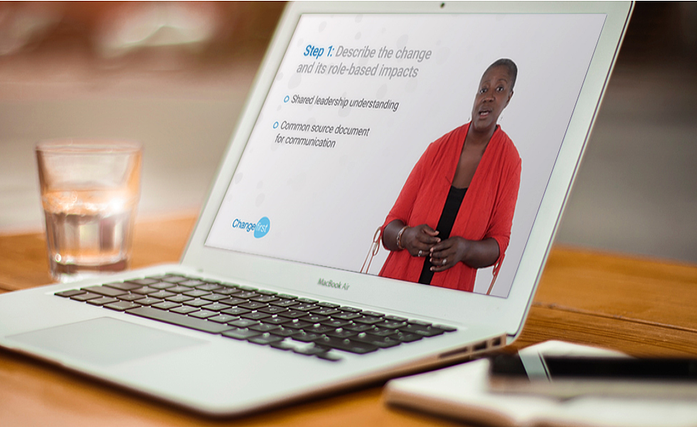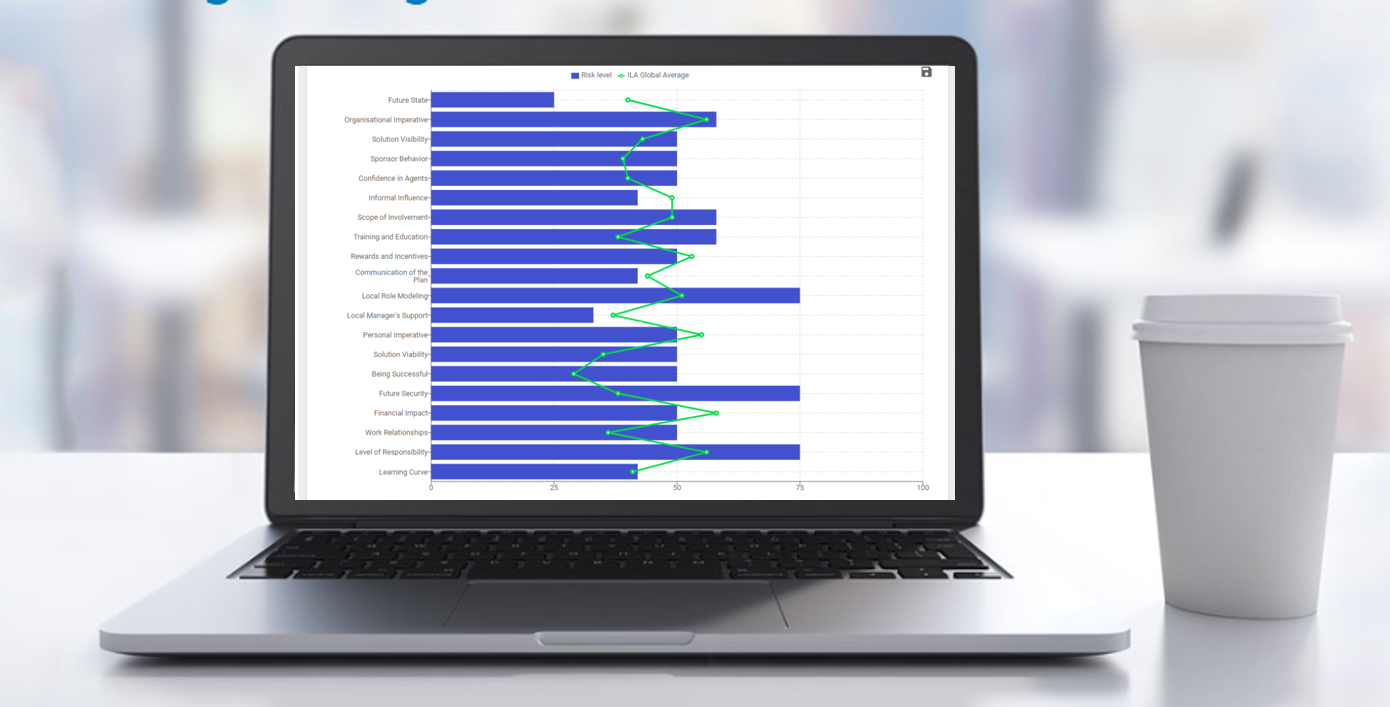In the first 3 blog posts in this series on Enterprise Change Management (ECM) we took a look at:
Blog 1 - A definition of Enterprise Change Management
Blog 2 - Change Maturity – effectively baselining your Enterprise Change Management strategy
Blog 3 – The Critical role of Adaptive Leadership in your ECM approach
In this 4th post we turn our attention to a real-life case study which involved Changefirst working with a major transport service and infrastructure provider to implement Enterprise Change Management across their organisation.
 Building enterprise-level Change Management (ECM) capability requires significant investment of time, resources, effort, and a plan to develop change management maturity. When working with organisations we use our Change Management Maturity Model to help them understand their starting point and develop a realistic plan for building the maturity they need.
Building enterprise-level Change Management (ECM) capability requires significant investment of time, resources, effort, and a plan to develop change management maturity. When working with organisations we use our Change Management Maturity Model to help them understand their starting point and develop a realistic plan for building the maturity they need.
Start small but significant
We have found that:
- if we can start small, but significant, transferring tools, skills and analytics capability to individuals and teams in the organisation with the biggest responsibility for delivering change; then we have social proof.
- social proof builds trust and a belief that process and consistency (common language and methodology) will improve productivity.
- organisations may have decided to buy, rather than build a Change Management methodology, but flexibility still matters – flexibility to integrate with other business/project processes and to be used on projects of different magnitude and complexity.
These characteristics were crucial to the success of our engagement with a major transport service and infrastructure provider – and this blog details the challenge, solution and benefits which Changefirst was able to provide them with.
The client and the challenge
In an organisation with a £37.5bn investment budget and responsibility for 20,000 miles of track, infrastructure, scheduling etc., correct project and change management is vital. The client recognised that change was everyone’s business and wanted to take an Enterprise Change Management approach to change delivery. They also recognised that managers have a pivotal, and difficult, role during periods of major change. Very often they are managing business as usual targets and competing change demands – all impacting them personally in their role, and the performance and behaviour of the teams they lead.
The client had a project and program management framework used to drive project delivery in the organisation. However, this framework on its own did not manage the potential people risks and people engagement needed to deliver successful change programs at an organisation wide level.
What it needed was an Enterprise-level solution that would:
- best integrate with the existing project and program framework
- be easy to scale and teach to project and Change Management teams
- be customisable to different change needs inside the organisation
The solution
Managing the Value Gap in Change
Failing to engage people sufficiently in major organisational change creates a significant gap in value that is promised from the project Business Case - the difference between solution delivery and actual benefits delivery associated with the project. In addition, an organisation’s historical performance is a useful indicator of their ability to effectively close the value gap on future initiatives.

So, we started our engagement with a diagnosis of our client’s past implementation performance – using powerful risk assessment tools on Changefirst’s digital change platform – Roadmap Pro®. A summary of the findings is shown in the table below:
 Source: Changefirst database
Source: Changefirst database
Our starter tool gave us a shared understanding of:
- likely commitment, ownership and resistance levels that could act as a barrier to success
- specific risk dimensions and issues that could repeat and must be managed so as not to slow down implementation
Our significant database – perhaps the second largest global change management database – was used to help the organisation query and compare against similar risk data from the wider transport industry. This benchmarking capability in the Changefirst platform helped them validate important planning, Go/No-Go decisions.
Not wanting to repeat the mistakes of the past, the organisation felt that internal teams – including change/project teams and business managers – needed to have a sense of ownership of their change programs and to reduce the dependency on external consultancy expertise. We worked with the Business Change Director change to create the roadmap for developing internal capability build and deploy integrated plans for managing changes through people.
A solution built around PCI and digital delivery
The client selected Changefirst’s globally recognized PCI® (People-Centred Implementation) methodology and digital toolkit Roadmap Pro as the combined framework that would:
- provide the flexibility to leverage and integrate with the existing project and program management framework
- deliver the capability to quickly scale and upskill a large number of project and business change professionals based in multiple locations
- allow for customisation to take account of the different change needs inside the organisation
PCI and Roadmap Pro tools were integrated with the existing project and program structures to create an overarching business change framework.
Essentially, the core project and program guidance of the existing framework was tailored to better meet the needs of the client. And, at the same time, aspects of dealing with people change were enhanced by providing a selection from Changefirst’s digital toolkit to support Business Change Managers along a project and program lifecycle. As the name PCI – People-Centred Implementation – suggests, this was focused on the people aspects of change. Aimed at avoiding common stumbling blocks such as poor sponsorship, insufficient commitment and employee resistance.
“We build our own internal capability to reduce our spending and dependence external consultants. Through action-learning workshops – come with a project, leave with a plan – we learn and use new skills, tools and processes immediately, see early results and build leadership support.”
- Lead Business Change Manager
3 key steps to get started
In the spirit of starting small but significant to get things started there were 3 key areas that were identified as being crucial for success.
# Step 1: Training the core change team
This step was focused on quickly training core business change & project managers in the effective use of the PCI methodology and to use the digital toolkit. A mixture of face-to-face planning workshops, digital onboarding and support allowed us to quickly create a Centre of Excellence. Visible success and increased team productivity on business-critical programs generated a great pull from the lines of Business for us to roll-out skills, tools and resources.
“Currently there are over 800 people across the organisation who have learned and are applying processes and tools within their change programs”
- Business Change Manager
# Step 2: Bring projects and people change together
At the same time, Changefirst worked with the client to assist with the integration of project and change management processes, tools and reporting to create ONE business change framework.
# Step 3: Develop role-based learning packages
In addition, role-based learning packages were developed and deployed so that everyone knew how to use the tools and processes to improve the part they play in the change process. In order to gain stronger sponsor engagement, 90 of the senior leaders within the organisation were trained through the Changefirst Executive workshop and the Executive Committee was given awareness training.
Real and early validation of a business-critical project - Authentication
One of the biggest change challenges that the client was facing was to gain buy-in on an authentication project from:
- nearly 100,000 people
- 23,000 of its own staff
- Plus 67,000 external suppliers and partners
In order to move authentication from 2% to 100% across all client and partner sites.
An example of how it worked in practice, one Program Implementation Manager, had 7 people working in his team – a small group who needed to be completely focused on delivery success. The overarching business framework helped prioritise the team’s efforts and the tools in the Roadmap Pro platform highlighted critical people risks and mitigation - to improve planning and delivery performance of the program.
“The USP of overarching business framework is it brings together the 7-stage MSP process with practical people processes, tools and data. I have been a business change manager for over 16 years, 8 of those in this organisation and this is the first time I have come across an integrated methodology which works the way I want to work".
- Program Implementation Manager
Real and ongoing benefits
There were a number of significant benefits for the internal change team from using PCI and the Roadmap Pro digital change platform including:
1. The ability to onboard quickly
The team were able to use a combination of face-to-face learning, on-demand learning and webinar sessions to tailor and disseminate learning. And get the coaching and application support needed from internal experts, in way that meant that no time s wasted.
This meant that over 60% of the program team’s time was spent doing essential engagement work with people across the organisation.

Roadmap Pro helps make change everyone’s business by providing quick and easy, on-demand access to tailored role-based learning
2. Change tools from the digital platform were used to gather real people data
The integrated tools in the Changefirst digital platform enabled the client to quickly collect data on the impact the change was having – directly from impacted groups –to validate and accelerate decision-making.
For example, the Adapter Readiness Assessment tool – one of the 11 multi-lingual diagnostics available to practitioners on Changefirst’s digital platform – was used to guide key “Go – No Go” decisions on the project.

The ability to collect, analyze and integrate data into change plans using our proven suite of assessment tools enabled the client to deliver change more quickly and effectively.
3. Key processes from PCI were used to kick-off workstream planning
This included:
- Clear articulation of the Change Purpose using change description processes from the methodology, helped to create a common understand and early engagement among the project leadership.
- Extensive mapping and analysis of the Route infrastructure using the Network Mapping process from the methodology, meant that different impacts and issues could be understood and planned for on a route-by-route basis. The authentication system needed to be “owned” by the Routes, and they needed to be able to endorse all plans and solutions being delivered
4. The use of Roadmap Pro provided a single source of change processes, tools, resources and just-in-time learning
Which made data-based planning, change implementation across the wider organisation and general ECM (Enterprise Change Management) development easier and more cost effective. Now:
- The integration of the PCI people framework into the existing client project and program framework has given the business the tools and capabilities to manage the people side of change
- There is both critical mass and leadership support for change management capability building with over 800 members of the clients’ change community, as well as 90 senior leaders, having been trained in the methodology
- The change framework is now part of clients’ DNA with internal knowledge transfer done via e-learning, video learning and “train-the-trainer” workshops; key tools and processes are now considered key elements of any change process within the business.
“We made a conscious decision to provide a visible sponsorship and public supporting role for the combined project and people framework, which has resulted in an organisation-wide buy-in for the initiative and executive level support. An active leadership role has been of crucial importance in the success of this change framework.”
Business Change Director
Closing thoughts
It is clear from the case study above that taking an Enterprise Change Management approach is a strategic undertaking. But it doesn’t have to be hard to get started.
By taking a “small but significant” approach and selecting a solution that delivers the digital capability that will enable you to get the skills, tools and data to the right people – and to make change everyone’s business is going to be key to your success.
We have extensive experience of helping organisations to do just that. If you would like to discuss this in more depth – free to contact us for a no-obligation discussion.
|
Do you need to take an Enterprise level approach to delivering Change in your organisation? Then find out more about how we can help you develop ECM capability in your organisation with:
|




Leave a comment